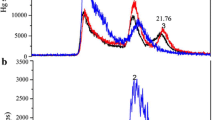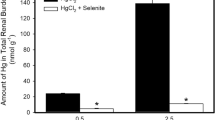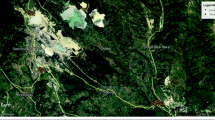Abstract
Inorganic mercury, administered to rats in a single dose of 0.5 mg Hg/kg is accumulated in the kidneys mainly in the soluble (54%) and nuclear (30%) fractions, showing decreasing tendency with time. Mitochondrial and microsomal fractions, initially accumulating approx. 11 and 6% of total Hg, show a tendency to increase the absolute level of Hg for the first week after administration. In the soluble fraction low-molecular weight, metallothioneinlike proteins are mainly responsible for the accumulation of mercury, in other fractions proteins of higher molecular weight prevail.
Zusammenfassung
Anorganisches Quecksilber, Ratten in einer einzelnen Dose von 0,5 mg Hg/kg verabreicht, wurde in den Nieren vorwiegend in der löslichen (54%) und in der Kern-Fraktion (30%) angereichert, und in beiden Fraktionen wurde eine zeitabhängige Abnahme festgestellt. In der mitochondrialen und mikrosomalen Fraktion, in denen zuerst ca. 11 und 6% Quecksilber gefunden wurde, konnte über die erste Woche eine zunehmende Tendenz festgestellt werden. In der löslichen Fraktion waren die metallothionein-ähnlichen Eiweißstoffe von niedrigem Molekulargewicht vorwiegend für die Bindung von Quecksilber verantwortlich. In anderen Zell-Fraktionen war Quecksilber meistens an Eiweiß-stoffe von hohem Molekulargewicht gebunden.
Similar content being viewed by others
References
Burton, K.: A study of the conditions and mechanism of the diphenylamine reaction for the colorimetric estimation of deoxyribonucleic acid. Biochem. J. 62, 315–323 (1956)
Chanda, S. K., Cherian, M. G.: Isolation and partial characterization of a mercury-binding nonhistone protein component from rat kidney nuclei. Biochem. biophys. Res. Commun. 50, 1013–1019 (1973)
Deakin, H., Ord, M. G., Stocken, L. A.: Glucose 6-phosphatedehydrogenase activity and thiol content of thymus nuclei from control and x-irradiated rats. Biochem. J. 89, 296–304 (1963)
De Duve, C., Berthet, J.: Enzymatic content of the mitochondrial fraction. Nature (Lond.) 172, 1143–1144 (1953)
Ellis, R. N., Fang, S. C.: Elimination, tissue accumulation and cellular incorporation of mercury in rats receiving an oral dose of 203Hg-labeled phenylmercuric acetate and mercuric acetate. Toxicol. appl. Pharmacol. 11, 104–113 (1967)
Fang, S. C.: The in vivo kinetics of mercury binding of kidney soluble proteins from rats receiving various mercurials. In: Mercury, mercurials and mercaptans (M. W. Miller, T. W. Clarkson, Eds.). Springfield: Thomas 1973
Jakubowski, M., Piotrowski, J. K., Trojanowska, B.: Binding of mercury in the rat: Studies using 203Hg and gel filtration. Toxicol. appl. Pharmacol. 16, 743–753 (1970)
Von Lancker, J. L., Holtzer, R. L.: Tissue fractionation studies of mouse pancreas. J. biol. Chem. 234, 2359–2363 (1959)
Lowry, O. H., Rosebrough, N. J., Farr, A. L., Randall, R. J.: Protein measurement with the Folin phenol reagent. J. biol. Chem. 193, 265–275 (1951)
Marsh, N. H., Ord, M. G., Stocken, L. A.: Thiol proteins in nuclei from rat liver and thymus. Biochem. J. 93, 539–544 (1964)
Nordberg, G. F., Skerfving, S.: In: Mercury in the environment (L. Friberg, J. Vostal, Eds.). Cleveland: CRC Press 1972
Nordberg, M., Trojanowska, B., Nordberg, G. F.: Studies on metal-binding proteins of low molecular weight from renal tissue of rabbits exposed to cadmium or mercury. Environ. Physiol. Biochem. 4, 149–158 (1974)
Norseth, T.: Intracellular distribution of mercury in rat liver after a single injection of mercuric chloride. Biochem. Pharmacol. 17, 581–593 (1968)
Patek, D. R., Frisell, W. R.: Quantitative studies on the flavins in the soluble fractions of heavy mitochondria of rat liver. Arch. Biochem. Biophys. 150, 339–346 (1972)
Piotrowski, J. K., Trojanowska, B., Wiśniewska-Knypl, J. M., Bolanowska, W.: Mercury binding in the kidney and liver of rats repeatedly exposed to mercuric chloride: Induction of metallothionein by mercury and cadmium. Toxicol. appl. Pharmacol. 27, 11–19 (1974)
Schneider, W. C.: Determination of nucleic acidic in tissues by Pentose analysis. Methods in enzymology, Vol. III. (S. P. Colowick, N. O. Kaplan Eds.), p. 680. New York: Academic Press 1957
Teng, C. S., Teng, C. T., Allfrey, V. G.: Properties of nuclear acidic proteins. J. biol. Chem. 10, 3597–3609 (1971)
Wiśniewska, J. M., Trojanowska, B., Piotrowski, J. K., Jakubowski, M.: Binding of mercury in the rat kidney by metallothionein. Toxicol. appl. Pharmacol. 16, 754–763 (1970
Author information
Authors and Affiliations
Additional information
This work was supported by the Polish-American agreement No. 05-009-2, with National Institute for Occupational Safety and Health, PHS, USA
Rights and permissions
About this article
Cite this article
Komsta-Szumska, E., Chmielnicka, J. & Piotrowski, J.K. Binding of inorganic mercury by subcellular fractions and proteins of rat kidneys. Arch. Toxicol. 37, 57–66 (1976). https://doi.org/10.1007/BF00353355
Received:
Issue Date:
DOI: https://doi.org/10.1007/BF00353355




